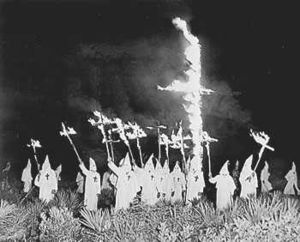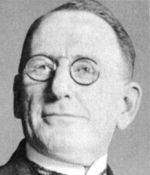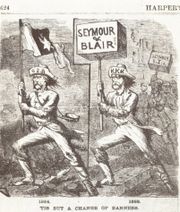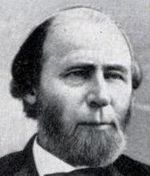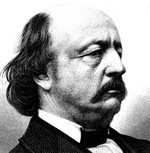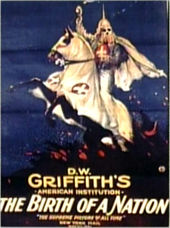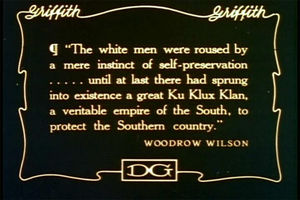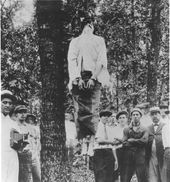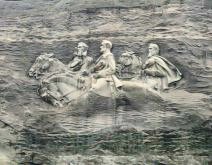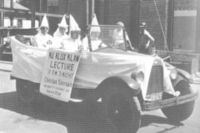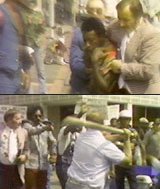Ku Klux Klan
2007 Schools Wikipedia Selection. Related subjects: North American History; Politics and government
Ku Klux Klan (KKK) is the name of a number of past and present fraternal organizations in the United States that have advocated white supremacy, anti-Semitism, racism, anti-Catholicism, homophobia, and nativism. These organizations have often used terrorism, violence and acts of intimidation such as cross burning to oppress African Americans and others.
The Klan's first incarnation was in 1865 by veterans of the Confederate Army, its main purpose was to resist Reconstruction, and it focused as much on intimidating " carpetbaggers" and " scalawags" as on putting down the freed slaves. It quickly adopted violent methods. A rapid reaction set in, with the Klan's leadership disowning violence, and Southern elites seeing the Klan as an excuse for federal troops to continue their activities in the South. The organization was in decline from 1868 to 1870 and was destroyed in the early 1870s by President Ulysses S. Grant's vigorous action under the Civil Rights Act of 1871 (also known as the Ku Klux Klan Act).
The founding, in 1915, of a second distinct group using the same name was inspired by the newfound power of the modern mass media, via the film The Birth of a Nation and inflammatory anti-Semitic newspaper accounts surrounding the trial and lynching of accused murderer Leo Frank. The second KKK was a formal membership organization, with a national and state structure, that paid thousands of men to organize local chapters all over the country. Millions joined and, at its peak in the 1920s, the organization included about 15% of the nation's eligible population. The second KKK typically preached racism, anti-Catholicism, anti-Communism, nativism, and anti-Semitism, and some local groups took part in lynchings and other violent activities. Its popularity fell during the Great Depression, and membership fell further during World War II, due to scandals resulting from prominent members' crimes and its support of the Nazis.
The name "Ku Klux Klan" has since been used by many different unrelated groups, including many who opposed the Civil Rights Act and desegregation in the 1950s and 1960s, with members of these groups eventually being convicted of murder and manslaughter in the deaths of Civil Rights workers and children (such as in the bombing of the 16th Street Baptist Church in Alabama). Today, dozens of organizations with chapters across the United States and other countries use all or part of the name in their titles, but their total membership is estimated to be only a few thousand. These groups, with operations in separated small local units, are considered extreme hate groups. The modern KKK has been repudiated by all mainstream media and political and religious leaders.
The first Ku Klux Klan
Creation
The original Ku Klux Klan was created after the end of the American Civil War on December 24, 1865, by six educated, middle-class Confederate veterans who were bored with postwar routine from Pulaski, Tennessee. The name was constructed by combining the Greek "kuklos" (circle) with " clan." It was at first a humorous social club centering on practical jokes and hazing rituals but soon spread into nearly every Southern state, launching a "reign of terror" against Republican leaders both black and white. Those assassinated during the campaign included Arkansas Congressman James M. Hinds, three members of the South Carolina legislature, and several men who had served in constitutional conventions."
From 1866 to 1867, the Klan began breaking up black prayer meetings and invading black homes at night to steal firearms. Some of these activities may have been modeled on previous Tennessee vigilante groups such as the Yellow Jackets and Redcaps.
In an 1867 meeting in Nashville, an effort was made to create a hierarchical organization with local chapters reporting to county leaders, counties reporting to districts, districts reporting to states, and states reporting to a national headquarters. The proposals, in a document called the "Prescript," were written by George Gordon, a former Confederate brigadier general. The Prescript included inspirational language about the goals of the Klan along with a list of questions to be asked of applicants for membership, which confirmed the focus on resisting Reconstruction and the Republican Party. The applicant was to be asked whether he was a Republican, a Union Army veteran, or a member of the Loyal League; whether he was "opposed to Negro equality both social and political;" and whether he was in favour of "a white man's government," "maintaining the constitutional rights of the South," "the reenfranchisement and emancipation of the white men of the South, and the restitution of the Southern people to all their rights," and "the inalienable right of self-preservation of the people against the exercise of arbitrary and unlicensed power."
Despite the work that came out of the 1867 meeting, the Prescript was never accepted by any of the local units. They continued to operate anonymously, and there never were county, district or state headquarters.
According to one oral report, Gordon went to former slave trader and Confederate General Nathan Bedford Forrest in Memphis and told him about the new organization, to which Forrest replied, "That's a good thing; that's a damn good thing. We can use that to keep the niggers in their place." A few weeks later, Forrest was selected as Grand Wizard, the Klan's national leader. In later interviews, however, Forrest denied the leadership role and stated that he never had any effective control over the Klan cells.
Activities
The Klan sought to control the political and social status of the freed slaves. Specifically, it attempted to curb black education, economic advancement, voting rights, and the right to bear arms. However, the Klan's focus was not limited to African Americans; Southern Republicans also became the target of vicious intimidation tactics. The violence achieved its purpose. For example, in the April 1868 Georgia gubernatorial election, Columbia County cast 1,222 votes for Republican Rufus Bullock, but in the November presidential election, the county cast only one vote for Republican candidate Ulysses Grant.
Klan intimidation was often targeted at schoolteachers and operatives of the federal Freedmen's Bureau. Black members of the Loyal Leagues were also the frequent targets of Klan raids. In a typical episode in Mississippi, according to the Congressional inquiry
One of these teachers (Miss Allen of Illinois), whose school was at Cotton Gin Port in Monroe County, was visited ... between one and two o'clock in the morning on March, 1871, by about fifty men mounted and disguised. Each man wore a long white robe and his face was covered by a loose mask with scarlet stripes. She was ordered to get up and dress which she did at once and then admitted to her room the captain and lieutenant who in addition to the usual disguise had long horns on their heads and a sort of device in front. The lieutenant had a pistol in his hand and he and the captain sat down while eight or ten men stood inside the door and the porch was full. They treated her "gentlemanly and quietly" but complained of the heavy school-tax, said she must stop teaching and go away and warned her that they never gave a second notice. She heeded the warning and left the county.
In other violence, Klansmen killed more than 150 African Americans in a single county in Florida, and hundreds more in other counties.
An 1868 proclamation by Gordon demonstrates several of the issues surrounding the Klan's violent activities.
- Many black men were veterans of the Union Army, and were armed. From the beginning, one of the original Klan's strongest focuses was on confiscating firearms from blacks. In the proclamation, Gordon warned that the Klan had been "fired into three times," and that if the blacks "make war upon us they must abide by the awful retribution that will follow."
- Gordon also stated that the Klan was a peaceful organization. Such claims were common ways for the Klan to attempt to protect itself from prosecution. However, a federal grand jury in 1869 determined that the Klan was a "terrorist organization." Hundreds of indictments for crimes of violence and terrorism were issued. Klan members were prosecuted, and many fled jurisdiction, particularly in South Carolina.
- Gordon warned that some people had been carrying out violent acts in the name of the Klan. It was true that many people who had not been formally inducted into the Klan found the Klan's uniform to be a convenient way to hide their identities when carrying out acts of violence. However, it was also convenient for the higher levels of the organization to disclaim responsibility for such acts, and the secretive, decentralized nature of the Klan made membership fuzzy rather than clear-cut. In many ways the Klan was a military force serving the interests of the Democratic party, the planter class, and those who desired the restoration of white supremacy.
-
 The 1868 interview with Forrest: Interview with Nathan Bedford Forrest
The 1868 interview with Forrest: Interview with Nathan Bedford Forrest
By this time, only two years after the Klan's creation, its activity was already beginning to decrease and, as Gordon's proclamation shows, to become less political and more simply a way of avoiding prosecution for violence. Many influential southern Democrats were beginning to see it as a liability, an excuse for the federal government to retain its power over the South. Georgian B.H. Hill went so far as to claim "that some of these outrages were actually perpetrated by the political friends of the parties slain."
In an 1868 newspaper interview, Forrest boasted that the Klan was a nationwide organization of 550,000 men, and that although he himself was not a member, he was "in sympathy" and would "cooperate" with them, and could himself muster 40,000 Klansmen with five days' notice. He stated that the Klan did not see blacks as its enemy so much the Loyal Leagues, Republican state governments like Tennessee governor Brownlow's, and other carpetbaggers and scalawags. There was an element of truth to this claim, since the Klan did go after white members of these groups, especially the schoolteachers brought south by the Freedmen's Bureau, many of whom had before the war been abolitionists or active in the underground railroad. Many white southerners believed, for example, that blacks were voting for the Republican Party only because they had been hoodwinked by the Loyal Leagues. Black members of the Loyal Leagues were also the frequent targets of Klan raids. One Alabama newspaper editor declared that "The League is nothing more than a nigger Ku Klux Klan."
Decline and suppression
The first Klan was never well organized. As a secret or "invisible" group, it had no membership rosters, no dues, no newspapers, no spokesmen, no chapters, no local officers, no state or national officials. Its popularity came from its reputation, which was greatly enhanced by its outlandish costumes and its wild and threatening theatrics. As historian Elaine Frantz Parsons discovered :
"Lifting the Klan mask revealed a chaotic multitude of antiblack vigilante groups, disgruntled poor white farmers, wartime guerrilla bands, displaced Democratic politicians, illegal whiskey distillers, coercive moral reformers, bored young men, sadists, rapists, white workmen fearful of black competition, employers trying to enforce labor discipline, common thieves, neighbors with decades-old grudges, and even a few freedmen and white Republicans who allied with Democratic whites or had criminal agendas of their own. Indeed, all they had in common, besides being overwhelmingly white, southern, and Democratic, was that they called themselves, or were called, Klansmen."
As has been previously stated, Forrest's national organization had little control over the local Klans, which were highly autonomous. One Klan official complained that his own "so-called 'Chief'-ship was purely nominal, I having not the least authority over the reckless young country boys who were most active in 'night-riding,' whipping, etc., all of which was outside of the intent and constitution of the Klan..." Forrest ordered the Klan to disband in 1869, stating that it was "being perverted from its original honorable and patriotic purposes, becoming injurious instead of subservient to the public peace." Due to the national organization's lack of control, this proclamation was more a symptom of the Klan's decline than a cause of it. Historian Stanley Horn writes that "generally speaking, the Klan's end was more in the form of spotty, slow, and gradual disintegration than a formal and decisive disbandment." A reporter in Georgia wrote in January 1870 that "A true statement of the case is not that the Ku Klux are an organized band of licensed criminals, but that men who commit crimes call themselves Ku Klux."
Although the Klan was being used more and more often as a mask for nonpolitical crimes, state and local governments seldom acted against it. In lynching cases, whites were almost never indicted by all-white coroner's juries, and even when there was an indictment, all-white trial juries were extremely unlikely to vote for conviction. In many states, there were fears that the use of black militiamen would ignite a race war. When Republican Governor of North Carolina William Woods Holden called out the militia against the Klan in 1870, the result was a backlash that lost him the upcoming election.
Despite this power, there was resistance to Klan terror. "Occasionally, organized groups successfully confronted the Klan. White Union Army veterans in mountainous Blount County, Alabama, organized 'the anti-Ku Klux,' which put an end to violence by threatening Klansmen with reprisals unless they stopped whipping Unionists and burning black churches and schools. Armed blacks patrolled the streets of Bennettsville, South Carolina, to prevent Klan assaults."
There was also a national movement to crack down on the Klan, even though many Democrats at the national level questioned whether the Klan even existed or was just a creation of nervous Republican governors in the South. In January 1871, Pennsylvania Republican senator John Scott convened a committee which took testimony from 52 witnesses about Klan atrocities. Many Southern states had already passed anti-Klan legislation, and in February congressman (and former Union general) Benjamin Franklin Butler of Massachusetts (who was widely reviled by Southern whites) introduced federal legislation modeled on it. The tide was turned in favour of the bill by the governor of South Carolina's appeal for federal troops, and by reports of a riot and massacre in a Meridian, Mississippi courthouse, which a black state representative escaped only by taking to the woods.
In 1871, President Ulysses S. Grant signed Butler's legislation, the Ku Klux Klan Act, which was used along with the 1870 Force Act to enforce the civil rights provisions of the constitution. Under the Klan Act, federal troops were used rather than state militias, and Klansmen were prosecuted in federal court, where juries were often predominantly black. Hundreds of Klan members were fined or imprisoned, and habeas corpus was suspended in nine counties in South Carolina. These efforts were so successful that the Klan was destroyed in South Carolina and decimated throughout the rest of the country, where it had already been in decline for several years. Prosecutions were led by Attorney General Amos Tappan Ackerman. The tapering off of the federal government's actions under the Klan Act, ca. 1871–74, went along with the final extinction of the Klan, although in some areas similar activities, including intimidation and murder of black voters, continued under the auspices of local organizations such as the White League, Red Shirts, saber clubs, and rifle clubs. Even though the Klan no longer existed, it had achieved many of its goals, such as denying voting rights to Southern blacks.
-
 The 1871 Ku Klux Klan Act: Ku Klux Klan Act of 1871
The 1871 Ku Klux Klan Act: Ku Klux Klan Act of 1871
However, it took several more years for all Klan elements to be destroyed. On Easter Sunday, 1873, the bloodiest single instance of racial violence in the Reconstruction era happened during the Colfax massacre. The Massacre began when black citizens fought back against the Klan and its allies in the White league. As Louisiana black teacher and legislator John G. Lewis later remarked, "They attempted (armed self-defense) in Colfax. The result was that on Easter Sunday of 1873, when the sun went down that night, it went down on the corpses of two hundred and eighty negroes."
In 1882, long after the end of the first Klan, the Supreme Court ruled in United States vs. Harris that the Klan Act was partially unconstitutional, saying that Congress's power under the Fourteenth Amendment did not extend to private conspiracies. However, the Force Act and the Klan Act have been invoked in later civil rights conflicts, including the 1964 murders of Chaney, Goodman, and Schwerner; the 1965 murder of Viola Liuzzo; and Bray v. Alexandria Women's Health Clinic in 1991.
The second Klan
In the four and a half decades after the suppression of the first Ku Klux Klan, race relations in the United States remained very bad--the nadir of American race relations is often placed in this era and according to the Tuskegee Institute the 1890s were the peak decade for lynchings.
Creation
The founding of the second Ku Klux Klan in 1915 demonstrated the newfound power of modern mass media. The year saw three closely related events:
- The film The Birth of a Nation was released, mythologizing and glorifying the first Klan.
- Leo Frank, a Jewish man accused of the rape and murder of a young white girl named Mary Phagan, was lynched against a backdrop of media frenzy.
- The second Ku Klux Klan was founded with a new anti-immigrant and anti-Semitic agenda. The bulk of the founders were from an organization calling itself the Knights of Mary Phagan, and the new organization emulated the fictionalized version of the original Klan presented in The Birth of a Nation.
D. W. Griffith's The Birth of a Nation glorified the original Klan, which was by then a fading memory. His film was based on the book and play The Clansman and the book The Leopard's Spots, both by Thomas Dixon who said his purpose was "to revolutionize northern sentiment by a presentation of history that would transform every man in my audience into a good Democrat!" The film created a nationwide craze for the Klan. At a preview in Los Angeles, actors dressed as Klansmen were hired to ride by as a promotional stunt, and real-life members of the newly reorganized Klan rode up and down the street at its later official premiere in Atlanta. In some cases, enthusiastic southern audiences fired their guns into the screen.
The film's popularity and influence were enhanced by a widely reported endorsement of its factual accuracy by historian and U.S. President Woodrow Wilson (see below, under Political Influence) as a favour to an old friend. Much of the modern Klan's iconography, including the standardized white costume and the burning cross, are imitations of the film, whose imagery was itself based on Dixon's romanticized concept of old Scotland as portrayed in the novels and poetry of Sir Walter Scott rather than on the Reconstruction Klan.
The Birth of a Nation includes extensive quotations from Woodrow Wilson's History of the American People, e.g., "The white men were roused by a mere instinct of self-preservation ... until at last there had sprung into existence a great Ku Klux Klan, a veritable empire of the South, to protect the Southern country." Wilson, on seeing the film in a special White House screening on February 18, 1915, exclaimed, "It is like writing history with lightning, and my only regret is that it is all so terribly true." Wilson's family had sympathized with the Confederacy during the Civil War, and cared for wounded Confederate soldiers at a church. When he was a young man, his party had vigorously opposed Reconstruction, and as president he resegregated the federal government for the first time since Reconstruction.
Given the film's strong Democratic partisan message and Wilson's documented views on race and the Klan, it is not unreasonable to interpret the statement as supporting the Klan, and the word "regret" as referring to the film's depiction of Radical Republican Reconstruction. Later correspondence with Griffith, the film's director, confirms Wilson's enthusiasm about the film. Wilson's remarks were widely reported and immediately became controversial. Wilson tried to remain aloof from the controversy, but finally, on April 30, he issued a non-denial denial. His endorsement of the film greatly enhanced its popularity and influence, and helped Griffith to defend it against legal attack by the NAACP; the film, in turn, was a major factor leading to the creation of the second Klan in the same year.
In the same year, an important event in the coalescence of the second Klan was the lynching of Leo Frank, a Jewish factory manager. In sensationalistic newspaper accounts, Frank was accused of fantastic sexual crimes and of the murder of Mary Phagan, a girl employed at his factory. He was convicted of murder after a questionable trial in Georgia (the judge asked that Frank and his counsel not be present when the verdict was announced due to the violent mob of people surrounding the court house). His appeals failed (Supreme Court Justice Oliver Wendell Holmes dissented, condemning the intimidation of the jury as failure to provide due process of law). The governor then commuted his sentence to life imprisonment, but a mob calling itself the Knights of Mary Phagan kidnapped Frank from the prison farm and lynched him. Ironically, much of the evidence in the murder actually pointed to the factory's black janitor, Jim Conley, who the prosecution claimed only helped Frank to dispose of the body.
For many southerners who believed Frank to be guilty, there was a strong resonance between the Frank trial and The Birth of a Nation, because they saw an analogy between Mary Phagan and the film's character Flora, a young virgin who throws herself off a cliff to avoid being raped by the black character Gus, described as "a renegade, a product of the vicious doctrines spread by the carpetbaggers."
The Frank trial was used skillfully by Georgia politician and publisher Thomas E. Watson, the editor for The Jeffersonian magazine at the time and later a leader in the reorganization of the Klan who was later elected to the U.S. Senate. The new Klan was inaugurated in 1915 at a meeting led by William J. Simmons on top of Stone Mountain, and attended by aging members of the original Klan, along with members of the Knights of Mary Phagan.
Simmons found inspiration for this second Klan in the original Klan's "Prescripts," written in 1867 by George Gordon (a former Confederate brigadier general) in an attempt to give the original Klan a sense of national organization. The Prescript states as the Klan's purposes:
- First: To protect the weak, the innocent, and the defenseless from the indignities, wrongs and outrages of the lawless, the violent and the brutal; to relieve the injured and oppressed; to succor the suffering and unfortunate, and especially the widows and orphans of the Confederate soldiers.
- Second: To protect and defend the Constitution of the United States ...
- Third: To aid and assist in the execution of all constitutional laws, and to protect the people from unlawful seizure, and from trial except by their peers in conformity with the laws of the land.
Membership
Historians in recent years have obtained membership rosters of some local units and matched the names against city directory and local records to create statistical profiles of the membership. Big city newspapers were unanimously hostile and often ridiculed the Klansmen as ignorant farmers. Detailed analysis from Indiana shows the stereotype was false:
Indiana's Klansmen represented a wide cross section of society: they were not disproportionately urban or rural, nor were they significantly more or less likely than other members of society to be from the working class, middle class, or professional ranks. Klansmen were Protestants, of course, but they cannot be described exclusively or even predominately as fundamentalists. In reality, their religious affiliations mirrored the whole of white Protestant society, including those who did not belong to any church.
The Klan was successful in recruiting throughout the country, but the membership turned over rapidly. Still, millions joined and at its peak in the 1920s the organization included about 15% of the nation's eligible population and had chapters across the United States. There were even clans founded in Canada, most notably in Saskatchewan, where there was a large clan movement against Catholic immigrants.
This Klan was operated as a profit-making venture by its leaders, and participated in the boom in fraternal organizations at the time. Organizers signed up hundreds of new members, who paid initiation fees and bought KKK costumes. The organizer kept half the money and sent the rest to state or national officials. When the organizer was done with an area, he organized a huge rally, often with burning crosses and perhaps a ceremonial presentation of a Bible to a local Protestant minister. He left town with all the money. The local units operated like many fraternal organizations, occasionally bringing in speakers. The state and national officials had little or no control over the locals and rarely or never attempted to forge them into political activist groups.
Political influence
The second Ku Klux Klan rose to great prominence and spread from the South into the Midwest and Northern states and even into Canada. At its peak, Klan membership exceeded 4 million and comprised 20% of the adult white male population in many broad geographic regions, as high as 40% in some areas. Most of the membership resided in Midwestern states.
Through sympathetic elected officials, the KKK controlled the governments of Tennessee, Indiana, Oklahoma, and Oregon in addition to some of the Southern legislatures. Klan influence was particularly strong in Indiana, where Republican Klansman Edward Jackson was elected governor in 1924, and the entire apparatus of state government was riddled with Klansmen. In another well-known example from the same year, the Klan decided to make Anaheim, California, into a model Klan city; it secretly took over the city council, but was voted out in a special recall election.
Klan delegates played a significant role at the pathsetting 1924 Democratic National Convention in New York City, often called the " Klanbake Convention" as a result. The convention initially pitted Klan-backed candidate William McAdoo against New York Governor Al Smith, who drew the opposition of the group because of his Catholic faith. After days of stalemates and rioting, both candidates withdrew in favour of a compromise. Klan delegates defeated a Democratic Party platform plank that would have condemned their organization. On July 4, 1924, thousands of Klansmen converged on a nearby field in New Jersey where they participated in cross burnings, burned effigies of Smith, and celebrated their defeat of the platform plank.
There is also evidence that in certain states, such as Alabama, the KKK was not a mere hate group and showed a genuine desire for political and social reform. Because of the elite conservative political structure in Alabama, the state's Klansmen were among the foremost advocates of better public schools, effective prohibition enforcement, expanded road construction, and other " progressive" political measures. In many ways these progressive political goals, which benefited ordinary and lower class white people in the state, were the result of the Klan offering these same people their first chance to install their own political champions into office.
By 1925 the Klan was a powerful political force in the state, as powerful figures like J. Thomas Heflin, David Bibb Graves, and Hugo Black manipulated the KKK membership against the power of the "Big Mule" industrialists and Black Belt planters who had long dominated the state. Black was elected Senator in 1926 and became a leading supporter of the New Deal. Appointed to the Supreme Court in 1937, the revelation that he was a former Klansman shocked the country but he stayed on the Court. In 1926 Bibb Graves, a former chapter head, won the governor's office with KKK members' support. He led one of the most progressive administrations in the state's history, pushing for increased education funding, better public health, new highway construction, and pro-labor legislation.
However, as a result of these political victories, KKK vigilantes, thinking they enjoyed governmental protection, launched a wave of physical terror across Alabama in 1927, targeting both blacks and whites. The Klan not only targeted people for violating racial norms but also for perceived moral lapses. In Birmingham, the Klan raided local brothels and roadhouses. In Troy, Alabama, the Klan reported to parents the names of teenagers they caught making out in cars. One local Klan group also "kidnapped a white divorcee and stripped her to her waist, tied her to a tree, and whipped her savagely." The conservative elite counterattacked. Grover C. Hall, Sr., editor of the Montgomery Advertiser, began a series of editorials and articles attacking the Klan for their "racial and religious intolerance." Hall ended up winning a Pulitzer Prize for his crusade. Other newspapers also kept up a steady, loud attack on the Klan as violent and un-American. Sheriffs cracked down on Klan violence. The counterattack worked; the state voted for Catholic Al Smith for president in 1928, and the Klan's official membership in Alabama plunged to under six thousand by 1930.
At the peak of the Klan's political power, a number of highly notable political figures in the U.S. and Canada joined the Klan or flirted with membership. The list includes two Supreme Court justices and, according to evidence which is in some cases contested, possibly two presidents.
Decline
The second Klan collapsed partly as a result of the backlash against their actions and partly as a result of a scandal involving David Stephenson (at the time a member of the Republican Party, after previous active membership in the Socialist Party and then in the Democratic Party), the Grand Dragon of Indiana and fourteen other states, who was convicted of the rape and murder of Madge Oberholtzer in a sensational trial (she was bitten so many times that one man who saw her described her condition as having been "chewed by a cannibal"). According to historian Leonard Moore, at the heart of the backlash to the Klan's actions and the resulting scandals was a leadership failure which caused the organization's collapse:
- Stephenson and the other salesmen and office seekers who maneuvered for control of Indiana's Invisible Empire lacked both the ability and the desire to use the political system to carry out the Klan's stated goals. They were disinterested in, or perhaps even unaware of, grass roots concerns within the movement. For them, the Klan had been nothing more than a means for gaining wealth and power. These marginal men had risen to the top of the hooded order because, until it became a political force, the Klan had never required strong, dedicated leadership. More established and experienced politicians who endorsed the Klan, or who pursued some of the interests of their Klan constituents, also accomplished little. Factionalism created one barrier, but many politicians had supported the Klan simply out of expedience. When charges of crime and corruption began to taint the movement, those concerned about their political futures had even less reason to work on the Klan's behalf.
As a result of these scandals, the Klan fell out of public favour in the 1930s and withdrew from political activity. Grand Wizard Hiram Evans sold the organization in 1939 to James Colescott, an Indiana veterinarian, and Samuel Green, an Atlanta obstetrician, but they were unable to stanch the exodus of members. The Klan's image was further damaged by Colescott's association with Nazi-sympathizer organizations, the Klan's involvement with the 1943 Detroit Race Riot, and efforts to disrupt the American war effort during World War II. In 1944 the IRS filed a lien for $685,000 in back taxes against the Klan, and Colescott was forced to dissolve the organization in 1944.
Folklorist and author Stetson Kennedy infiltrated the Klan after World War II and provided information on the Klan to media and law enforcement agencies. He also provided Klan information, including secret code words, to the writers of the Superman radio program, resulting in a series of four episodes in which Superman took on the KKK. Kennedy's intention to strip away the Klan's mystique and trivialize the Klan's rituals and code words likely did have a negative impact on Klan recruiting and membership. Kennedy eventually wrote a book based on his experiences, which became a bestseller during the 1950s and further damaged the Klan.
Later Ku Klux Klans
After the breakup of the second Klan, the name Ku Klux Klan began to be used by a number of independent groups. The following table shows the change in the Klan's estimated membership over time. (The years given in the table represent approximate time periods.)
| year | membership |
| 1920 | 4,000,000 |
| 1924 | 6,000,000 |
| 1930 | 30,000 |
| 1970 | 2,000 |
| 2000 | 3,000 |
Beginning in the 1950s, a large number of the individual Klan groups began to resist the civil rights movement. This resistance involved numerous acts of violence and intimidation. Among the more notorious events of this time period were:
- The assassination of NAACP organizer Medgar Evers in Mississippi. In 1994, former Ku Klux Klansman Byron De La Beckwith was convicted of Evers' murder.
- The 1966 firebombing death of NAACP leader Vernon Dahmer Sr., 58, also in Mississippi. In 1998 former Ku Klux Klan wizard Sam Bowers was convicted of Dahmer's murder. Two other Klan members were indicted with Bowers, but one died before trial, and the other's indictment was dismissed.
- The 1963 bombing of the 16th Street Baptist Church in Alabama, which killed four children. Four Klansmen were named as suspects in they were not prosecuted until years later. The Klan members were Robert Chambliss, convicted in 1977, Thomas Blanton and Bobby Frank Cherry, convicted of murder in 2001 and 2002. The fourth suspect, Herman Cash, died before he was indicted.
- The murder of Willie Edwards, Jr., in 1957. Edwards was forced by Klansmen to jump to his death from a bridge into the Alabama River.
- The 1964 murders of civil rights workers Chaney, Goodman, and Schwerner in Mississippi. In June 2005, Klan member Edgar Ray Killen was convicted of manslaughter in the murders.
- The 1965 murder of Viola Liuzzo, a Southern-raised white mother of five who was visiting the South from her home in Detroit to attend a civil rights march. At the time of her murder Liuzzo was transporting Civil Rights Marchers.
In addition to these murders, Klan groups also killed a number of others during this time period, with many of these acts going unreported. For example, in 1951 Harry T. Moore, a school-teacher and state director of the NAACP, died with his wife, Harriette, when their house was bombed. Even though an FBI investigation at the time turned up several suspects, no one was prosecuted in the case. "Forty years later, a former Marine and Ku Klux Klansman told NAACP officials that he and other Klansmen had conspired with law enforcement officials to plan and carry out the murder.... According to a subsequent report from the Southern Regional Council in Atlanta, the homes of forty black Southern families were bombed during 1951 and 1952. Some, like Harry Moore, were social activists whose work exposed them to danger, but most were either people who had refused to bow to racist convention, or were simply innocent bystanders, unsuspecting victims of random white terrorism."
However, while the post-war Klan groups were extremely violent, this was also the period that saw a successful push back against the KKK. For example, in a 1958 North Carolina incident, the Klan burned crosses at the homes of two Lumbee Native Americans who had associated with white people, and then held a nighttime rally nearby, only to find themselves surrounded by hundreds of armed Lumbees. Gunfire was exchanged, and the Klan was routed.
In 1964, the FBI's COINTELPRO-WHITE HATE program infiltrated and disrupted the Klans. Yet COINTELPRO also occupied a curiously ambiguous position in the civil rights movement, since it used its tactics of infiltration, disinformation, and violence not only against violent far-left and far-right groups such as the Klan and the Weathermen, but simultaneously against peaceful organizations such as Martin Luther King, Jr.'s Southern Christian Leadership Conference. This ambivalence was shown dramatically in the case of the murder of Liuzzo, who was shot on the road by four Klansmen in a car, of whom one was an FBI informant. After she was murdered, the FBI spread false rumors that she was a communist, and that she had abandoned her children in order to have sex with black civil rights workers. Regardless of the FBI's ambivalence, Jerry Thompson, a newspaper reporter who infiltrated the Klan in 1979, reported that COINTELPRO's efforts had been highly successful in disrupting the Klan. Rival Klan factions both accused each other's leaders of being FBI informants, and one leader, Bill Wilkinson of the Invisible Empire, Knights of the Ku Klux Klan, was in fact later revealed to have been working for the FBI.
Once the century-long struggle over black voting rights in the South had ended, the Klans shifted their focus to other issues, including affirmative action, immigration, and especially busing ordered by the courts in order to desegregate schools. In 1971, Klansmen used bombs to destroy ten school buses in Pontiac, Michigan, and charismatic Klansman David Duke was active in South Boston during the school busing crisis of 1974. Duke also made efforts to update its image, urging Klansmen to "get out of the cow pasture and into hotel meeting rooms." Duke was leader of the Knights of the Ku Klux Klan from 1974 until he resigned from the Klan in 1978. In 1980, he formed the National Association for the Advancement of White People, a white nationalist political organization. He was elected to the Louisiana State House of Representatives in 1989 as a Republican, even though the party threw its support to a different Republican candidate.
In this period, resistance to the Klan became more common. Thompson reported that in his brief membership in the Klan, his truck was shot at, he was yelled at by black children, and a Klan rally that he attended turned into a riot when black soldiers on an adjacent military base taunted the Klansmen. Attempts by the Klan to march were often met with counterprotests, and violence sometimes ensued.
Vulnerability to lawsuits has encouraged the trend away from central organization, as when, for example, the lynching of Michael Donald in 1981 led to a civil suit that bankrupted one Klan group, the United Klans of America. Thompson related how many Klan leaders who appeared indifferent to the threat of arrest showed great concern about a series of multimillion-dollar lawsuits brought against them as individuals by the Southern Poverty Law Centre as a result of a shootout between Klansmen and a group of African Americans, and curtailed their activities in order to conserve money for defense against the suits. Lawsuits were also used as tools by the Klan, however, and the paperback publication of Thompson's book was canceled because of a libel suit brought by the Klan.
Klan activity has also been diverted into other racist groups and movements, such as Christian Identity, neo-Nazi groups, and racist skinheads.
The Ku Klux Klan today
Although often still discussed in contemporary American politics as representing the quintessential "fringe" end of the far-right spectrum, today the group only exists in the form of a number of isolated, scattered groups with a total membership numbering no more than a few thousand. In a 2002 report on "Extremism in America", the Jewish Anti-Defamation League wrote "Today, there is no such thing as the Ku Klux Klan. Fragmentation, decentralization and decline have continued unabated." However, they also noted that the "need for justification runs deep in the disaffected and is unlikely to disappear, regardless of how low the Klan's fortunes eventually sink."
Today the only known former member of the Klan to hold a federal office in the United States is Democratic Senator Robert Byrd of West Virginia, who says he "deeply regrets" joining the Klan over half a century ago, when he was about 24 years old. There are currently no known members of the Klan who also hold a Federal office.
Also recent attacks include the lynching of blaenavon schoolboy Adam South by known KKK member 'Silent' Bob Davies. Some of the larger KKK organizations currently in operation include:
- Bayou Knights of the Ku Klux Klan, prevalent in Texas, Oklahoma, Arkansas, Louisiana and other areas of the Southeastern US.
- Church of the American Knights of the Ku Klux Klan
- Imperial Klans of America
- Knights of the White Kamelia
- Knights of the Ku Klux Klan, headed by National Director Pastor Thom Robb, and based in Zinc, Arkansas. Claims to be biggest Klan organization in America today. It refers to itself as the "sixth era Klan" and continues to be a racist group.
There are also a number of smaller organizations using the Klan name.
As of 2005, there were an estimated 3,000 Klan members, divided between estimates of 100 and 158 chapters of a variety of splinter organizations, about two-thirds of which were in former Confederate states. The other third are primarily in the Midwest.
The ACLU has provided legal support to various factions of the KKK in defense of their First Amendment rights to hold public rallies, parades, and marches, and their right to field political candidates.
In a July 2005 incident, a Hispanic man's house was burned down in Hamilton, Ohio, after accusations that he sexually assaulted a nine-year-old white girl. Klan members in Klan robes showed up afterward to distribute pamphlets. In May 2006, a Ku Klux Klan group led an anti-immigration march in Russellville, Alabama.
Notable Klan leaders
- Don Black
- Sam Bowers
- David Duke
- Thomas Robb
Ku Klux Klan vocabulary
Membership in the Klan is secret, and the Klan, like many fraternal organizations, has signs members can use to recognize one another. A member may use the acronym AYAK (Are you a Klansman?) in conversation to surreptitiously identify himself to another potential member. The response AKIA (A Klansman I am) completes the greeting.
Throughout its varied history, the Klan has coined many words beginning with "KL" including:
- Klabee: treasurers
- Kleagle: recruiter
- Klecktoken: initiation fee
- Kligrapp: secretary
- Klonvocation: gathering
- Kloran: ritual book
- Kloreroe: delegate
- Kludd: chaplain
All of the above terminology was created by William Simmons, as part of his 1915 "revival" of the Klan. The Reconstruction-era Klan used different titles; the only titles to carry over were "Wizard" (or Imperial Wizard) for the overall leader of the Klan, "Night Hawk" for the official in charge of security, and a few others, mostly for regional officers of the organization.
